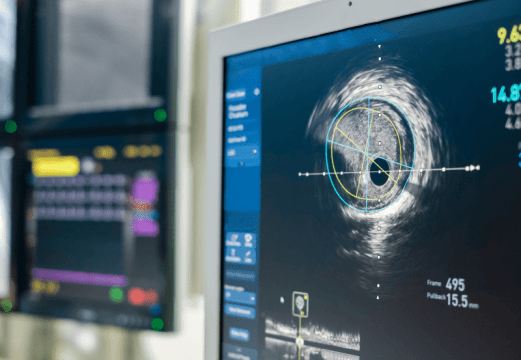Complementary imaging allows for the identification of numerous scenarios not visible with conventional angiography (ICA), both for the assessment of differential diagnoses and the improvement of percutaneous coronary intervention (PCI) outcomes. Advantages include assessment of plaque characteristics, vessel plaque burden, stent edge dissection, vessel diameter, and correct apposition, among others.

While intravascular ultrasound (IVUS) was introduced over 30 years ago, supporting evidence has been consolidated only in recent years by means of multiple randomized studies. Optical coherence tomography (OCT) has improved the spatial resolution of IVUS, reaching up to 10–20 μm (10 times more than IVUS – ≈150 μm), thus allowing for an improvement in resolution. However, this advancement in image quality has not yet been fully demonstrated in studies.
The aim of the study presented by D. Giacoppo and D. Capodanno was to assess the imaging alternatives to guide PCI, whether it be coronary angiography, IVUS, or OCT, by means of a meta-analysis (frequentist and Bayesian).
Included studies required patients to undergo PCI (with a drug-eluting stent, DES, in any clinical setting), randomized to one of the evaluated arms (coronary angiography, IVUS, and OCT) and a follow-up >6 months. The primary endpoints (PEPs) were target-vessel revascularization (TLR) and acute myocardial infarction (AMI), while the secondary endpoints included ischemia-driven revascularization, target-vessel AMI, all-cause mortality and cardiac mortality, stent thrombosis, and major adverse cardiovascular events (MACE).
Read also: Edge-to-Edge Repair in Cardiogenic Shock.
Researchers included 24 randomized studies (15,489 patients: IVUS versus coronary angiography, 46.4%, 7189 patients; OCT versus coronary angiography, 32.1%, 4976 patients; OCT versus IVUS, 21.4%, 3324 patients). Among these, 16 were multicenter trials, and 16 were conducted solely in Asia. Mean patient age was 64.4 years; in average, 25.9% of patients were women, and the prevalence of diabetes ranged from 13% to 100% (average: 33.5%). In general, patients with bifurcation lesions and left main coronary artery disease were excluded.
Regarding the PEP (TLR), IVUS was associated with a decrease in treated-vessel revascularization compared with coronary angiography (odds ratio [OR]: 0.69 [95% confidence interval (CI), 0.54–0.87]), whereas OCT vs. coronary angiography (OR: 0.83 [95% CI, 0.63–1.09]) and OCT vs. IVUS (OR: 1.21 [95% CI, 0.88–1.66]) showed no significant differences. In addition, IVUS showed the highest probability of being categorized as the best strategy (rank first: 87.4%). Upon a Bayesian analysis, results were consistent.
Regarding the co-primary outcome of AMI, there were no significant differences between the strategies, with a trend in favor of OCT (frequentist and Bayesian model). When assessing secondary outcomes, there was a decrease in ischemia-driven TLR in favor of IVUS vs. coronary angiography. When assessing mortality with frequentist analysis, IVUS-guided PCI was associated with a reduction in all-cause mortality, whereas when assessing cardiac mortality, there was a significant decrease with both IVUS and OCT.
Conclusions
The analysis conducted by Giacoppo et al. showed that IVUS-guided PCI reduced any type of new treated-vessel revascularization compared with coronary angiography. However, when evaluating OCT, there were no significant differences. It should be noted that, upon a Bayesian analysis, the use of intravascular imaging failed to find differences regarding AMI and treated-vessel AMI.

Dr. Omar Tupayachi.
Member of the Editorial Board of SOLACI.org.
Reference: Giacoppo D, Laudani C, Occhipinti G, Spagnolo M, Greco A, Rochira C, Agnello F, Landolina D, Mauro MS, Finocchiaro S, Mazzone P, Ammirabile N, Imbesi A, Raffo C, Buccheri S, Capodanno D. Coronary Angiography, Intravascular Ultrasound, and Optical Coherence Tomography in the Guidance of Percutaneous Coronary Intervention: A Systematic Review and Network Meta-Analysis. Circulation. 2024 Feb 12. doi: 10.1161/CIRCULATIONAHA.123.067583. Epub ahead of print. PMID: 38344859.
Subscribe to our weekly newsletter
Get the latest scientific articles on interventional cardiology





